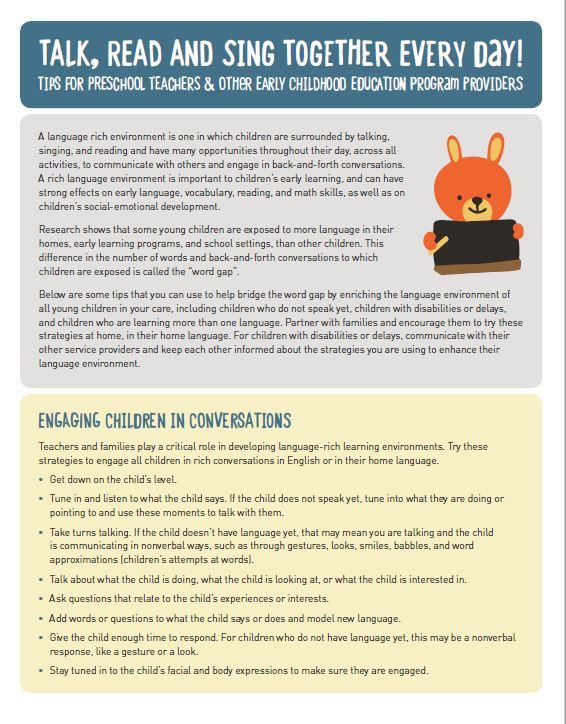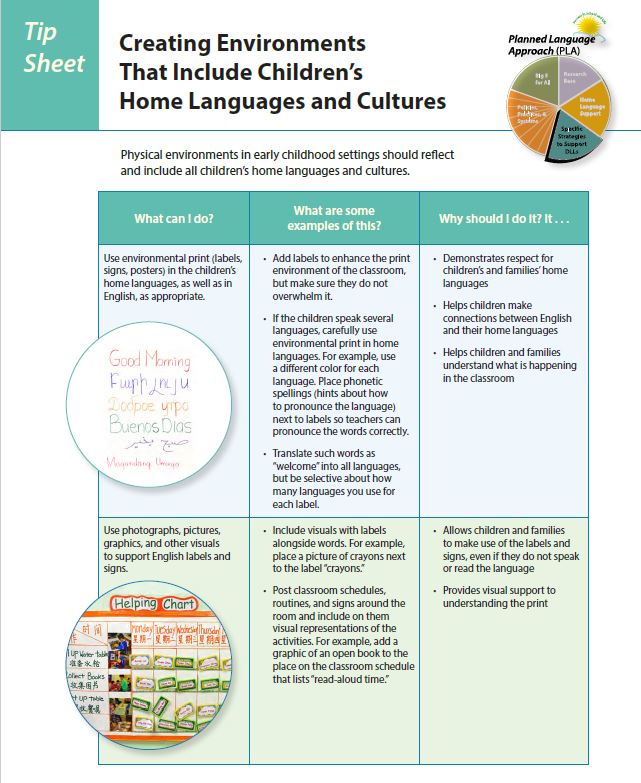As an early care and education provider, you play a critical role in the health and wellbeing of children. You are also very well positioned to help identify children who might need extra help in their development. This FREE, online training course, Watch Me! Celebrating Milestones and Sharing Concerns, helps you fulfill this role by providing tools and best practices for monitoring the development of children in your care and talking about it with their parents.
This 1-hour, 4-module course focuses on:
- Why monitoring children’s development is important
- Why you have a unique and important role in developmental monitoring
- How to easily monitor each child’s developmental milestones
- How to talk with parents about their child’s development
Click the link to start the class: Watch Me! Celebrating Milestones and Sharing Concerns | CDC
Research shows the importance of providing children with many language opportunities, including talking, reading, and singing. This tip sheet, created by the U.S. Departments of Education and Health and Human Services in partnership with Too Small to Fail, gives excellent practical tips on facilitating a rich conversation with preschool children, including using questions, expanding the child’s words, and interactive reading!
Tips for language rich -Preschool
Supporting the home language is essential in helping strengthen cultural and linguistic identity and developing a connection to the second language. Intentionality in supporting home language can also aid in supporting family relationships and engagement. These tip sheets, created by the Administration for Children and Families, Office of Head Start, give caregivers practical tips and ideas to include children’s home language in your program!
Creating Environments That Include Children’s Home Languages and Cultures
Including Children’s Home Languages and Cultures
Encourage children to name animals and then move their body like that animal. They can incorporate sounds as well. You might even make an ‘animal parade’. Talk about the different ways they move their bodies to look like the animal and name the body parts they use. (The book From Head to Toe by Eric Carle is a great resource for this activity).
Goal: Expand children’s vocabulary related to body parts and animal names and move in a variety of ways.
Set up a space where children can create cards and letters for each other. You can include different types and sizes of paper and envelopes, stickers, stamps/stampers, and a list of the names of the children. Encourage children to draw and write or dictate messages to one another. You can create a mailbox space using a box with dividers or hanging shoe storage and label a spot for each child.

Goal: Children will communicate with each other with drawing and writing.
If you would like to learn more about emergent writing check out the Learn, Share, and Grow series about writing development on the Professional Development page.
Ask children to gather sticks (if outside) or provide Popsicle sticks or straws (if indoors). Then have children create shapes or letters using the sticks. Talk about the number of sticks you need to create specific shapes or letters and encourage the children to talk together about what they made.
Goal: Children will use sticks to create shapes and letters
“ZERO TO THREE is a national, nonprofit organization that provides parents, professionals and policymakers the knowledge and know-how to nurture early development. Our mission is to ensure that all babies and toddlers have a strong start in life.”
Zero to Three has resources related to development, health, screen time, relationships with families and handouts for ages and stages. The resources are presented in a variety of formats and geared for educators, child care providers, advocates and parents.
A fun activity with old books or magazines is to create story cards that show a sequence. Cut out 3-6 pictures that show actions as part of a sequence of events. Glue the cut out pictures to construction paper or cards. You could laminate them or cover them with clear contact paper for extra sturdiness. Children can work individually or in small groups to place the cards into order. These sets of cards can be made available for children to choose to work on independently. If children need help you can use sequencing language (first, next, last, etc.) to support children’s vocabulary growth.
Goal: This activity supports children’s language skills and cognitive development in terms of memory, sequencing patterns, and problem solving.







